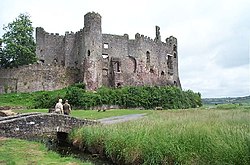Laugharne Castle
| Laugharne Castle Welsh: Castell Talacharn | |
|
Carmarthenshire | |
|---|---|
 Laugharne Castle | |
| Location | |
| Town: | Laugharne |
| History | |
| Information | |
| Condition: | ruined |
Laugharne Castle is a castle in the town of Laugharne in southern Carmarthenshire. It stands guarding the estuary of the River Tâf.
History
The original castle was established by 1116 as the castle of Robert Courtemain, who is recorded to have entrusted its care to Bleddyn ap Cedifor. The castle also was the meeting place of Henry II of England with Rhys ap Gruffudd in 1171-1172, and where they agreed a treaty of peace. When Henry II died in 1189, the castle along with St Clears and Llansteffan were seized by Rhys ap Gruffudd of Deheubarth in 1189, Laugharne Castle may have been burnt down at this time.
The Castle was rebuilt by the Normans and in 1215 was captured by Llywelyn ap Iorwerth (Llywelyn the Great) in his campaign across South Wales.
By 1247 Laugharne was granted to the de Brian family. In 1257 Guy De Brian was captured at Laugharne Castle by Llywelyn ap Gruffudd and the castle destroyed.
It was in Laugharne in 1403 that Owain Glyndwr's rebellion stalled. Perhaps lulled into complacency, he was tricked by an ambush and lost 700 men. A local story has it that a soothsayer warned Owain to leave the area or be captured, and he retreated. After this the rebellion petered out as the King, Henry IV, brought greater numbers to the field and by 1415, Owain Glyndwr had disappeared, fading into myth.
In 1584, Elizabeth I granted Laugharne to Sir John Perrott, said to have been the illegitimate son of Henry VIII.
During the Civil War, Laugharne was captured by Royalists in 1644. Later in the year the castle's own namesake took it for Parliament; the forces of Major-General Rowland Laugharne attacked the castle and after a week-long siege in which much of the castle was damaged by cannon fire, the Royalist garrison finally surrendered. The castle was slighted to prevent any further use.
Romantic ruin
After Parliament destroyed the castle's defences, it was left to decay, and became the romantic ruin it is today. During the 18th century, and around the start of the 19th century the outer ward was laid with formal gardens. The gazebo overlooking the estuary was used in the 1930s and 40s by the author Richard Hughes, who leased Castle House during this period. Laugharne has also inspired two great modern writers, who worked in the garden gazebo overlooking the river. Richard Hughes wrote his novel In Hazard here, and Dylan Thomas, Laugharne's most famous resident, worked in the castle on its Portrait of the Artist as a Young Dog.
Outside links
| ("Wikimedia Commons" has material about Laugharne Castle) |
References
Coordinates: 51°46′11″N 4°27′43″W / 51.76972°N 4.46194°W